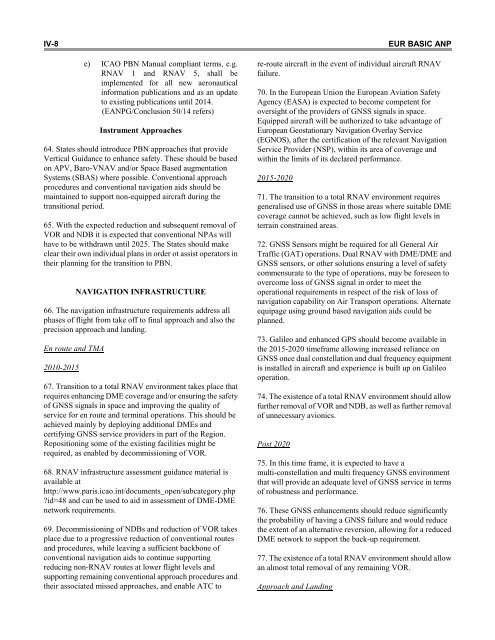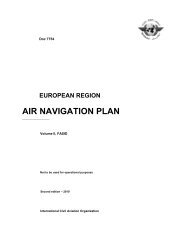7754 Vol 1 Flyleaf - ICAO Public Maps
7754 Vol 1 Flyleaf - ICAO Public Maps
7754 Vol 1 Flyleaf - ICAO Public Maps
You also want an ePaper? Increase the reach of your titles
YUMPU automatically turns print PDFs into web optimized ePapers that Google loves.
IV-8 EUR BASIC ANP<br />
e) <strong>ICAO</strong> PBN Manual compliant terms, e.g.<br />
RNAV 1 and RNAV 5, shall be<br />
implemented for all new aeronautical<br />
information publications and as an update<br />
to existing publications until 2014.<br />
(EANPG/Conclusion 50/14 refers)<br />
Instrument Approaches<br />
64. States should introduce PBN approaches that provide<br />
Vertical Guidance to enhance safety. These should be based<br />
on APV, Baro-VNAV and/or Space Based augmentation<br />
Systems (SBAS) where possible. Conventional approach<br />
procedures and conventional navigation aids should be<br />
maintained to support non-equipped aircraft during the<br />
transitional period.<br />
65. With the expected reduction and subsequent removal of<br />
VOR and NDB it is expected that conventional NPAs will<br />
have to be withdrawn until 2025. The States should make<br />
clear their own individual plans in order ot assist operators in<br />
their planning for the transition to PBN.<br />
NAVIGATION INFRASTRUCTURE<br />
66. The navigation infrastructure requirements address all<br />
phases of flight from take off to final approach and also the<br />
precision approach and landing.<br />
En route and TMA<br />
2010-2015<br />
67. Transition to a total RNAV environment takes place that<br />
requires enhancing DME coverage and/or ensuring the safety<br />
of GNSS signals in space and improving the quality of<br />
service for en route and terminal operations. This should be<br />
achieved mainly by deploying additional DMEs and<br />
certifying GNSS service providers in part of the Region.<br />
Repositioning some of the existing facilities might be<br />
required, as enabled by decommissioning of VOR.<br />
68. RNAV infrastructure assessment guidance material is<br />
available at<br />
http://www.paris.icao.int/documents_open/subcategory.php<br />
?id=48 and can be used to aid in assessment of DME-DME<br />
network requirements.<br />
69. Decommissioning of NDBs and reduction of VOR takes<br />
place due to a progressive reduction of conventional routes<br />
and procedures, while leaving a sufficient backbone of<br />
conventional navigation aids to continue supporting<br />
reducing non-RNAV routes at lower flight levels and<br />
supporting remaining conventional approach procedures and<br />
their associated missed approaches, and enable ATC to<br />
re-route aircraft in the event of individual aircraft RNAV<br />
failure.<br />
70. In the European Union the European Aviation Safety<br />
Agency (EASA) is expected to become competent for<br />
oversight of the providers of GNSS signals in space.<br />
Equipped aircraft will be authorized to take advantage of<br />
European Geostationary Navigation Overlay Service<br />
(EGNOS), after the certification of the relevant Navigation<br />
Service Provider (NSP), within its area of coverage and<br />
within the limits of its declared performance.<br />
2015-2020<br />
71. The transition to a total RNAV environment requires<br />
generalised use of GNSS in those areas where suitable DME<br />
coverage cannot be achieved, such as low flight levels in<br />
terrain constrained areas.<br />
72. GNSS Sensors might be required for all General Air<br />
Traffic (GAT) operations. Dual RNAV with DME/DME and<br />
GNSS sensors, or other solutions ensuring a level of safety<br />
commensurate to the type of operations, may be foreseen to<br />
overcome loss of GNSS signal in order to meet the<br />
operational requirements in respect of the risk of loss of<br />
navigation capability on Air Transport operations. Alternate<br />
equipage using ground based navigation aids could be<br />
planned.<br />
73. Galileo and enhanced GPS should become available in<br />
the 2015-2020 timeframe allowing increased reliance on<br />
GNSS once dual constellation and dual frequency equipment<br />
is installed in aircraft and experience is built up on Galileo<br />
operation.<br />
74. The existence of a total RNAV environment should allow<br />
further removal of VOR and NDB, as well as further removal<br />
of unnecessary avionics.<br />
Post 2020<br />
75. In this time frame, it is expected to have a<br />
multi-constellation and multi frequency GNSS environment<br />
that will provide an adequate level of GNSS service in terms<br />
of robustness and performance.<br />
76. These GNSS enhancements should reduce significantly<br />
the probability of having a GNSS failure and would reduce<br />
the extent of an alternative reversion, allowing for a reduced<br />
DME network to support the back-up requirement.<br />
77. The existence of a total RNAV environment should allow<br />
an almost total removal of any remaining VOR.<br />
Approach and Landing














